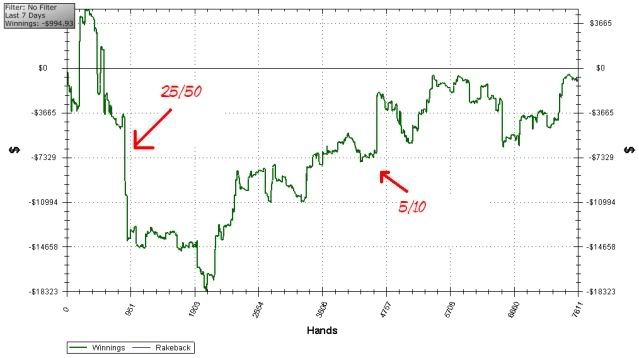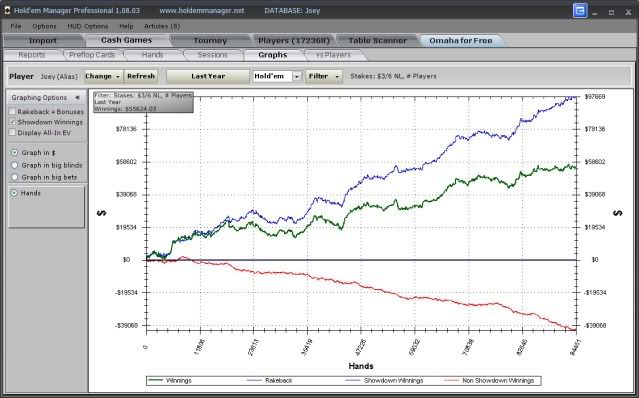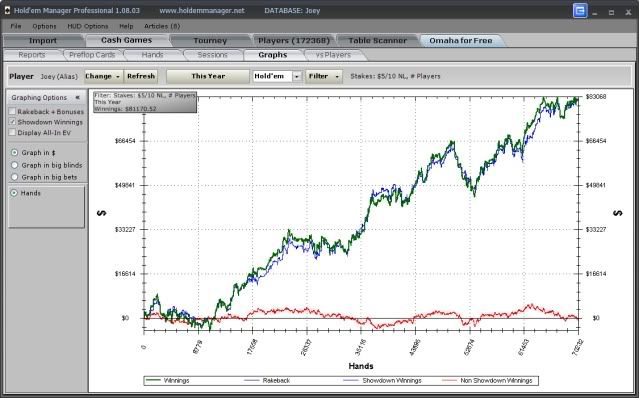Poker has been going pretty average. My downswing hit about -29K at its lowest, recovered to -15K, then fell back to -21K, then hit -7k today after I somehow pulled off a massive 14K four hour session. I’ve had four hours of coaching now, two hours each with iRock and DJ Sensei, and I think it’s definitely helped me immensely. The thing that struck me most about iRock is just how well he knew his opponents. We play in roughly the same games, but whereas I simply classified each opponent very generally (good reg, bad reg, nit, fish etc.), he knew the ins and outs of every opponent. I felt really exposed with my lack of knowledge and so I’ve been working hard on training my reads ever since. I decided to turn off my HUD on FTP since I knew the player base there very well and by some freak of nature my HUD won’t work on Stars or iPoker anyway so I’m actually playing three-quarters HUD-less these days and I think it’s helped me to train my reads quite a lot, though I’m still nowhere near iRock’s level.
Anyway I thought today I’d do the analysis for the first of my “unorthodox hands” that I posted last month. I won’t lie, I’ve been putting this off because I’ve been too lazy and busy with assessments, but now seems as good a time as any. To recap, here’s the first hand.
No-Limit Hold'em, $10.00 BB (6 handed) - Hold'em Manager Converter Tool from FlopTurnRiver.com
MP ($1373)
CO ($1476)
Hero (Button) ($1000)
SB ($965)
BB ($884)
UTG ($2633)
Preflop: Hero is Button with 8 , J
, J
3 folds, Hero bets $25, 1 fold, BB calls $15
Flop: ($55) 3 , Q
, Q , 8
, 8 (2 players)
(2 players)
BB checks, Hero checks
Turn: ($55) 4 (2 players)
(2 players)
BB bets $41, Hero raises $123, BB raises $341, Hero raises $852 (All-In), 1 fold
Total pot: $819
Results:
Hero had 8 , J
, J (one pair, eights).
(one pair, eights).
Outcome: Hero won $1409
The ‘play’ I want to talk most about is actually just the turn raise – the 4-bet shove was just a cool extension that made the hand more interesting.
Anyway, on the flop we get checked to with middle pair on a fairly co-ordinated board. Betting is usually fine, but against this particular opponent I decided to check back and play a bit of pot control. The reason for this is that this opponent was apt to check-raise with a wide range and I’d have trouble knowing where I was at. I’d probably call and hate life if he bet the turn no matter what turn card came, whether it was a diamond, an overcard, or a brick. His range would be something like Qx, sets, JT, T9, J9, flush draws, and air. Since flush draws can contain an Ace or King, this means any turn card 9 or higher or any diamond could conceivably make him the best hand, if he didn’t have it already. In other words, the turn would be an impossible situation to play.
Ironically, if this board was rainbow I’d definitely c-bet and ‘dare’ him to check-raise. In that scenario we’re in much better shape for two reasons. First, since flush draws are no longer in his range, we can evaluate turn cards much more easily: a turned Ace or King is not nearly as much of a scare card anymore, nor is any diamond – that’s 1/4 of the deck alone that we’re no longer afraid of! Secondly, since flush draws actually have decent equity against our pair of eights, our equity actually skyrockets once they’re taken out since sets are few and far between and his range will now comprise a lot of those JT gut-shot type hands, a lot of air (his air frequency would actually probably increase since a dry Q83r flop is a good flop for me to c-bet and hence a good flop for him to c/r bluff), and arguably less Qx hands (since there is far less value in check-raising, say, KQ on Q83r than there is on Q83 with a flush draw). In other words, calling down becomes a lot easier and more profitable.
Anyway, back to the actual hand, and we find ourselves led into on the turn. This is a spot where 99% of the world I think calls without much thought. They figure that their hand is underrepresented, their opponent could be leading with a lot of draws, they can’t fold because it’d be too weak, raising would be turning their hand into a bluff, etc. etc. The problem I think with this logic is that against a good opponent your hand is face up as a weak Queen, JJ-99, or an 8. You could conceivably have picked up a spade draw, but it’s pretty likely you would’ve c-bet it on the flop (since it would’ve been air on the flop) so in your opponent’s eyes your range is a lot more narrow than you might think. This in turn means that the river again becomes very difficult for you to play. They know your hand, but you don’t know theirs. If the river comes a diamond and they bet, what do you do? If the river comes a spade and they bet, what do you do? If the river comes an Ace, a King, a Ten, a brick, and they bet, what do you do? You can see that you’re put into a complete guessing game. It’s a spot where the river becomes a very unprofitable situation for you. You could fold to any river bet, but if a river bet is coming about 75% of the time, then calling the turn is just burning money. At the same time, if you do call the river bet, you’ll be putting in money bad a great percentage of the time.
What I’ve decided to do therefore is to occasionally throw in this turn raise. It’s essentially a showdown raise and the last money I intend to put in the pot. The idea is that if you do it infrequently (and you should definitely only do it infrequently since it’s extremely exploitable, as we shall see in a second) it should freeze them since it’s such a WTF line and they should fold their air and gut-shots and flat with their flush draws (VERY few people will 3-bet back over you with a naked flush draw when faced with this line on the turn) and queens. They’re obviously going to keep putting money in with sets, but that’s a tiny part of their range and you can easily fold to the re-raise. Indeed, the extra money you lose on the turn versus sets by raising you probably would’ve lost on the river anyway by calling. The great thing about this line I think is that when you put in money on the turn you’re usually putting it in good. You’re now charging their flush draws and they’ll be forced to play very face up on the river. If they hit they’ll lead and you can fold. If they hit and check, then you can check behind and they’ll feel completely owned, having put money in behind on the turn and extracted nothing from you on the river. If they miss they’ll almost always check and you’ll check back and win a nice pot. If they have a queen the river will check through and you’ll lose the same amount as if you called the turn and called the river (even less actually since the additional turn raise amount will be smaller than a river bet by your opponent had you just called the turn). In other words, it’s a super awesome situation to be in! You’ve managed to turn a situation where you had no idea where you were at into one that’s incredibly easy to play. Cool huh? So what’s the catch?
Well the catch is demonstrated in this hand quite nicely. The problem with this line is that I’m representing absolutely nothing but a turned set or a turned two pair (and it can’t be a two pair containing the top pair since I’m usually betting that). In other words my value-range is miniscule and a smart opponent, like the one in this hand, may 3-bet bluff you back and move you off your hand. If you do this infrequently though, most opponents will give you credit and only 3-bet back with sets.
So then, why didn’t I fold when he 3-bet back in this particular hand? Well, as soon as I raised I could seriously see the wheels begin turning in his head. I knew my line was BS and so, it seemed, did he. The important thing to note though is that when he 3-bet me back his range is still sets or air. It’s not one of those spots where if I’m more likely to be bluffing he should widen his value range. There is absolutely no value in re-raising a Queen since I’m folding my bluffs and if I have the turned set he’s crushed. The far superior and more logical line for a Queen is simply to call down.
So then, faced with a range of sets or air, what is the weight I should give to each? A lot of people know that combinatorically air combinations far outweigh set combinations, but they have to remember that not all air hands will make this 3-bet raise while all sets will. So rather than asking yourself “how many air hands can he have”, you have to ask yourself “GIVEN he’s 3-bet the turn, how many air hands can he have”. Since the whole purpose of this line was to freeze him meaning that air hands should be non-existent in this spot, this was a very difficult question to answer. In the end though, I looked at what set combinations he could have. QQ obviously 3-bets preflop, so that’s one set out of the equation. In relation to 33 and 44, I made a pivotal assumption that they were not in his range and I think that assumption was very accurate. Why? First, my opponent was a good winning reg. This meant that he should know that flatting small pairs from the blinds versus a button open is just plain bad (since my button opening range is so wide, set mining with those pairs is just burning money unless he wants to make a whole bunch of moves postflop with 2 outs if called). Secondly, my opponent literally has the highest 3-bet frequency on PokerStars. Thus, if there’s one person who would be 3-betting 22-55 preflop rather than flatting them, he was it. This meant that the only set my opponent realistically could have was 88, and since I had an 8 myself, there was literally only one combination of hands left in the deck that could beat me. With that knowledge, I shipped it in, and the rest, as they say, is a cool looking hand for a poker blog :).
 , 3
, 3
 , 9
, 9 , 2
, 2 (2 players)
(2 players) (2 players)
(2 players) (2 players)
(2 players) , 3
, 3 (three of a kind, threes).
(three of a kind, threes). , 9
, 9 (three of a kind, nines).
(three of a kind, nines).





